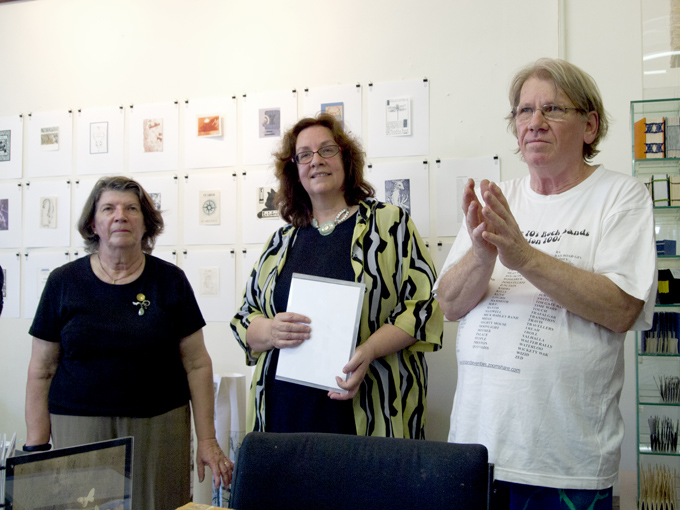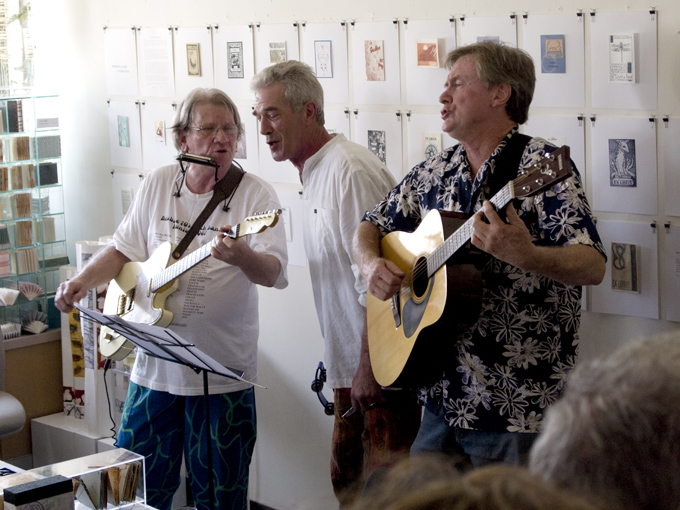Archive for December 2012
RUBY SPOWART TURNS 85
I visited my mother last month just after the family birthday celebration given by her three sons and their families. 85 is a big number when it comes to years lived on this planet and one of Ruby’s recent projects gave me an opportunity to reflect on the life that she has witnessed. Ruby just finished an Apple iPhotobook entitled Meet my ancestors which contains family portraits, group photographs, texts and personal visual ephemera from the last 170 years of her, and mine–Ancestors. This is the third book she has made of this genre, the first being an artists book made from collected images of each year of her life from 1 to 21, and the second, a photobook entitled Bringing home the grain in which she describes the agricultural processes of grain growing and harvesting she encountered in her childhood on a farm in Northern Victoria.
The Meet my ancestors project brought me in contact with the value of the family photograph, either professionally made or made at home as a box Brownie snapshot, in its ability to provide proof of existence and the aging process encountered by a subject over many successive portraits. Another feature of Ruby’s assemblage and ordering of these family photographs is that they all have a connected linage. This is distinctly different to family photos encountered in junk shops, antique shops and car boot sales. In these circumstances the photographs are separated from their meaning, they become isolated examples of someone and not ‘a’ specific ‘known’ individual—a kind of image orphan.
These family portraits are not just photos as she has added a text as well and linked it to other records like personal correspondence and newspaper reports—usually of obituaries. A picture may be worth the proverbial 1000 words but a picture and an appropriate amount of text can place it within a context, a time and ancestral linage. John Berger wrote about this necessary liaison of photo and text in his book Another way of telling1. He says: ‘In the relation between a photograph and words, the photograph begs for an interpretation, and the words usually supply it. The photograph, irrefutable as evidence but weak in meaning, is given a meaning by the words.’
In contemporary society with the popularity of TV programs like Who do you think you are and the online availability of genealogical information there is a heightened interest in our family trees and ancestry. And, as Ruby has lived half of the time covered by her book it is important for her to be engaged in such a project. What is equally exciting for me is that she sits before a computer, sending and receiving communiqués and images from the extended family, she orders, optimizes and designs the pages of the book (with a little help from me): when she was 3 could she have ever dreamed of such a thing…
SEE earlier post about Ruby and her work
Ruby can be contacted through LINKEDIN
Happy Birthday Ruby,
Son Doug, and Vicky
.
1. Berger, J 1982, ‘Appearances’, in Another way of telling, Writers and Readers Publishing Cooperative Society Ltd., London, UK.














‘BOOKPLATES UNBOUND’: The Cooper+Spowart contribution
leave a comment »
Here are our contributions to the Bookplates Unbound project – SEE previous post for details
.
VICTORIA COOPER: ex libris, dedicated to Dr Dorothy Shaw
Victoria Cooper’s Bookplate
A statement about this work…
To many of her colleagues Dorothy was enigmatic and modest about her personal and past life. Under the surface of this quiet and reserved nature, she had an inquiring, creative mind. I always found her willing to venture into the unchartered territory of the imagination, while still grounded in the everyday physical world.
Dorothy also had distinct methods of working: I could always count on her typewritten notes clearly outlining for me the information on her specimens intended for deposit into the Plant Pathology Herbarium. These typed notes may seem a standard communication—but Dorothy used a typewriter, similar to the old black 1940s Imperial machine. It seemed that this was an idiosyncratic protest against the unwanted aspects of the digital paradigm invading her world. It must be noted that although Dorothy did not utilise aspects of digital communication, she was readily accepting of the digital world. Dorothy not only embraced fully the digital art I was creating but she also recognised the important role of digital technology and work practices necessary in contemporary scientific research.
In the visual work for my PhD—involving fresh water aquatic fungi—I consulted Dorothy’s considerable knowledge on these organisms. Our exchanges were creative and fertile, inter-relating knowledge and concepts from both science and visual art. The designs and patterns in this bookplate were selected from a collection of microscopic photomicrographs of aquatic fungi I created for the visual component of my PhD. I also chose the typeface Courier, for the bookplate to reflect the typewritten notations that were emblematic of Dorothy’s recordings.
Dorithy is passed away now and although I did not get to see her library, I am sure it was diverse, interesting and informative. I am equally confident that she would have a manually typed (non-digital) catalogue and reference list for each book. From these connections and perceptions of this creative, dedicated scientist, I created this bookplate—I have made it to evoke the life of Dorothy Shaw as a Library: one full of mystery, knowledge, life’s challenges and experiences.
Victoria Cooper
.
DOUG SPOWART: A homage to a Walter Benjamin comment about book collecting
Doug’s Bookplate
.
A statement about this work…
In Walter Benjamin’s 1931 essay, Unpacking My Library: A Talk About Book Collecting, I found a discussion that echoed my desire for accumulating books and their assembly into a personal library. In the text Benjamin shares his love of the process of: finding, acquiring books, building a library, and what it means to possess books—many of them.
In this bookplate I make reference to Benjamin’s comment that a collection may include books from other libraries that were loaned and never returned. This covert act has historically been something I’d encountered from others who did not return books. After a time, if I approached the borrower seeking the book, their usual response was the denial of ever borrowing the volume – or – that it had already been returned.
I cannot deny that I too have lusted after books seen in private libraries, books in bookshops and catalogues that I could never afford, or books held in institutional repositories. I have thought, like Benjamin, of borrowing and then never giving them back.
However this bookplate* is pure fantasy and not an admission of guilt. It is my commentary on Benjamin’s proposition in the form of a modified bookplate to indicate the changed ownership, dubious provenance as well as a signifier of obsessive possession.
Doug Spowart
* I must acknowledge that I do have a book in my library that is stamped ‘The Kodak Technical Library’ over which is confidently signed ‘Julian Smith’. And there are annotations and marginalia in the same pencil that are indicators of Smith’s provenance. I bought the book from a respectable Melbourne bookseller in 2002.
Share this:
Written by Cooper+Spowart
December 24, 2012 at 3:35 am
Posted in Doug Spowart, Exhibitions, Victoria Cooper
Tagged with aquatic fungi, Australian bookplate artists, Bookplates, Bookplates Unbound, comments about book collecting, Dr Dorothy Shaw, Walter Benjamin